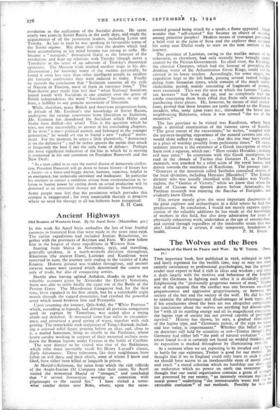Ancient Highways
Old Routes of Western Iran. By Sir Aurel Stein. (Macmillan. 42s.)
IN this work Sir Aurel Stein embodies the last of four fruitful journeys in historical Iran that were made in the years 1932-1936. The earlier expeditions had included Iranian Baluchistan, to- gether with the provinces of Kerman and Faro. We now follow him in the longest of these expeditions in Western Iran.
Starting from Shiraz in November, 1935, and travelling, generally speaking, in a north-westerly direction throughout, Khuristan (the ancient Elam), Luristan and Kurdistan were traversed in turn, the journey only ending in the vicinity of Lake Krumia. Historic ground was trodden throughout, and ancient caravan routes were crossed which determined the course not only of trade, bu: also of conquering armies.
Shortly after leaving upland Ardukan, thanks in part to the valuable accounts given by Alexander the Great's historians, Stein was able to settle finally the exact site of the Battle of the Persian Gates. The Macedonian Conqueror had, for the first time, been repulsed in his first attack, but by a remarkable night march through the rugged mountains, had crushed the powerful army which stood between him and Persepolis.
Upon resuming the journey, Qala-Safid, the " White Fortress " which, according to legends, had defeated all previous conquerors until its capture by Tamerlane, was scaled after a trying climb and sketched. It measured some four miles in circumfer- ence, and possessed a good spring of water, together with rich. grazing. The remarkable rock sculptures of Tang-i-Surwak, includ- ing a colossal relief figure praying before an altar, and, close to it, a mailed horseman, bring us clearly to the Parthians, whose heavy cavalry working in support of their mounted archers over- threw the Roman legions under Crassus at the battle of Carrhae.
The next district to be visited was that of the Bakhtiares, which tribe must inevitably recall Sir Henry Layard's classic, Early Adventures. These tribesmen, like their neighbours, have fallen on evil days, and their chiefs, some of whom I knew and liked, have either been killed or languish in prison.
At Masjid-i-Sulaiman, the ruins from which the rich oilfields of the Anglo-Iranian Oil Company take their name, Sir Aurel visited the misnamed Masjid or "mosque," and concluded that " it served Zoroastrian worship in connexion with pilgrimages to the sacred fire." I have visited a some- what similar shrine near Baku, where, upon the snow- covered ground being struck by a spade, a flame appeared. Small wonder that " self-created " fire became an object of worship among primitive peoples! Modern means of transport permitted a brief visit to the ruins of Susa and the explorer then rejoined his camp near Dizful ready to start on the next section of his journey.
The province of Luristan, owing to the warlike nature of its tribesmen, as elsewhere, had only recently been brought under control by the Persian Government. Its chief river, the Karkhep, the classical Choaspes, which had the honour of providing the drinking water of the Achaemenian Great Kings, could not be crossed in its lower reaches. Accordingly, for some stages, the expedition kept to the left bank, passing several ruined bridges dating from Sassanian times, while remains of the much earlier chalcolithic period, mainly consisting of fragments of pottery, were examined. This was the area in which the famous " Luris- tan bronzes " had been dug up, and so completely had the tombs containing them been rifled that Stein only succeeded in purchasing three pieces. He, however, by means of trial excava- tions, proved that these bronzes are justly ascribed to the Kussite invaders, who, some 2,000 years B.c., introduced the horse into neighbouring Babylonia, where it was termed " the ass of the mountain."
The last province to be visited was Kurdistan, where Stein made a detailed examination of the famous caves of Karafto. " The great extent of the excavations," he writes, " coupled with the mystery-inspiring appearance of the natural caverns and rifts, would alone suffice to suggest . . . that this site may have served as a place of worship possibly from prehistoric times." Of extra- ordinary interest is the existence of a Greek inscription of which Stein took a squeeze, which ran: " Here resides Heraldes ; nothing evil may enter." In connexion with this Greek inscription, we read in the Annals of Tacitus that Gotarzes II, as Parthian monarch, was attacked by a rebel scion of the royal house, and driven towards the maintains of Kurdistan. The passage runs: " Gotarzes at the mountain called Sanbulos consulted oracles of the local divinities, including Hercules [Heraldes]." The Iranian divinity who was usually identified with Heraldes was Vereth- raghna, the " Genius of Victory," while we know that when the head of Crassus was thrown down before Artavasdes, the Parthian monarch was enjoying the Bacchae of Euripides, and evidently knew Greek.
This review merely gives the most important discoveries of the great explorer and archaeologist in a field where he had few predecessors. In conclusion, I would not merely express appre- ciation of the valuable additions he has made to the knowledge of workers in this field, but also deep admiration for years of physically exhausting work, undertaken at the age of seventy-four, and carried through regardless of the intolerable strain that was alas! followed by a serious, if only temporary, breakdown in


























 Previous page
Previous page